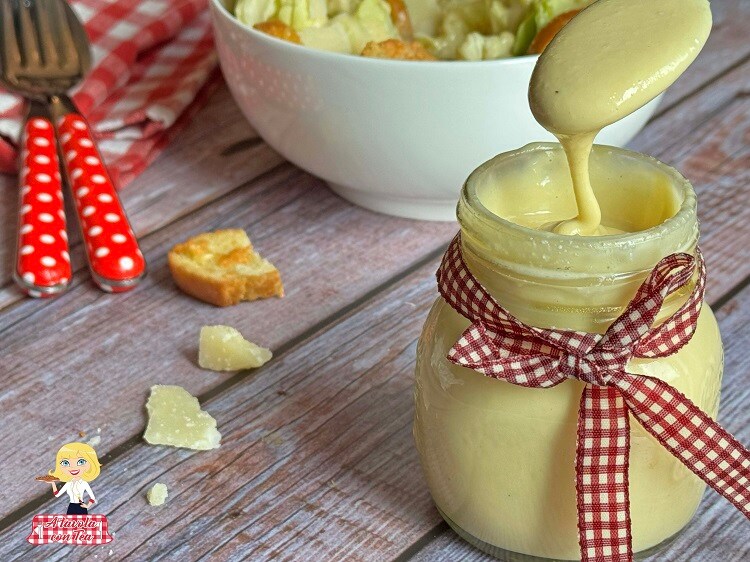HOMEMADE CAESAR SALAD: Crunchy, Creamy, and Unforgettable!
Do you want to impress your guests with a salad that tastes like fine dining but is surprisingly easy to prepare? The Homemade Caesar Salad is the answer! Forget supermarket bagged versions: this recipe will guide you step by step in creating a masterpiece of flavors and textures, from the crispy romaine lettuce to the golden croutons, from fresh Parmesan to the light and irresistible Caesar dressing.
The inspiration for this recipe comes directly from the United States, where I tasted it for the first time at a friend’s and fell in love instantly. As soon as I returned to Italy, I recreated it, and from that moment it became the most requested salad by my family – a real success in getting even the little ones to eat vegetables!
The secret of this salad lies in its dressing, the Caesar salad sauce, easy to prepare in a bowl with a simple hand whisk. The result is a light, healthy dressing with a fresh flavor that encompasses notes of lemon, garlic, and the umami taste of Parmesan. All the ingredients are simple and probably already in your kitchen: romaine lettuce, Parmesan, croutons, and homemade Caesar dressing.
Once you try the Caesar Salad, you won’t go back. It’s better in every way: fresh, crunchy, creamy, and with the authentic taste you’d expect from a refined steakhouse. You can serve it as a light side dish or turn it into a complete meal by adding baked chicken breast, seared steak strips, or grilled shrimp. Prepare this wonder and delight everyone’s palate!

- Difficulty: Very easy
- Cost: Affordable
- Preparation time: 15 Minutes
- Cooking methods: Oven, Air fry
- Cuisine: American
- Energy 470.32 (Kcal)
- Carbohydrates 27.81 (g) of which sugars 2.46 (g)
- Proteins 14.10 (g)
- Fat 35.07 (g) of which saturated 8.79 (g)of which unsaturated 3.05 (g)
- Fibers 2.88 (g)
- Sodium 525.92 (mg)
Indicative values for a portion of 125 g processed in an automated way starting from the nutritional information available on the CREA* and FoodData Central** databases. It is not food and / or nutritional advice.
* CREATES Food and Nutrition Research Center: https://www.crea.gov.it/alimenti-e-nutrizione https://www.alimentinutrizione.it ** U.S. Department of Agriculture, Agricultural Research Service. FoodData Central, 2019. https://fdc.nal.usda.gov
Caesar Salad Ingredients
You can choose to make everything at home: from the croutons to the Caesar Dressing to the Mayonnaise (find my recipe HERE). Or purchase some of these ingredients already ready. I’ll leave the decision to you.
- 1/2 baguette (about 150-200 g)
- 3 tablespoons extra virgin olive oil
- 1 tablespoon fresh garlic (minced)
- 2 tablespoons grated Parmesan
- 1/2 cup mayonnaise
- 2 teaspoons Dijon mustard
- 2 teaspoons Worcestershire sauce
- 1 clove garlic (minced or crushed)
- 3 tablespoons lemon juice (fresh)
- 1/2 teaspoon fine salt
- 1 pinch black pepper
- 1/2 cup extra virgin olive oil
- 1/2 cup grated Parmesan
- 1 romaine lettuce (large or 2 small, or romaine hearts)
- 1/3 Parmigiano Reggiano DOP (shaved)
Tools
- Food Scale
- Bowl
- Small Bowl
- Hand Whisk
- Mandolin
- Baking Tray
- Baking Paper
- Oven
How to Prepare Classic Caesar Salad
Preheat the oven to 375°F. Slice the baguette lengthwise in half and then cut each half diagonally, obtaining pieces about 1/8 inch thick. Arrange the bread on a baking tray. In a small bowl, combine 3 tablespoons of extra virgin olive oil and 1 teaspoon of finely minced garlic. Drizzle the garlic oil over the bread pieces and sprinkle with 2 tablespoons of grated Parmesan. Mix well to coat evenly. Spread the bread in a single layer on the tray and bake at 375°F for 10-12 minutes, or until golden and crispy. Halfway through the baking, flip the croutons for even browning. Remove from oven and let cool completely.

In a large bowl, combine the mayonnaise, Dijon mustard, Worcestershire sauce, grated or pressed garlic, fresh lemon juice, fine salt, and freshly ground black pepper. With a hand whisk, beat vigorously until well blended and smooth. While continuing to whisk vigorously, slowly drizzle in the extra light olive oil. It is essential to pour the oil very gradually and whisk forcefully to emulsify the dressing, making it thick and shiny. Once all the oil is incorporated, add the 50 g of freshly grated Parmesan Reggiano and blend to combine. Your Caesar dressing is ready.

Prepare the lettuce: rinse the romaine lettuce leaves well under cold water, dry them thoroughly (preferably with a salad spinner), and cut or tear them into bite-sized pieces. Place them in a large serving bowl. Just before serving, add the prepared croutons and the Parmesan Reggiano (grated or shaved, using a vegetable peeler for the latter). Drizzle the salad with the homemade Caesar dressing and toss gently to coat the lettuce and croutons evenly. Serve immediately.

Notes on Ingredients and Tips
Romaine Lettuce: Use a whole head or fresh romaine hearts. Avoid pre-washed bagged salad, which tends to soften faster and doesn’t offer the same crispness. Cold, dry lettuce is the key to a crunchy salad.
Parmesan: Freshly grated or shaved Parmesan will have a superior flavor and texture compared to pre-grated, which often contains additives.
Croutons: This recipe produces irresistible croutons, and you’ll probably have enough for two salads, so you can save some for next time. You can also use sourdough bread for croutons with a deeper flavor.
Caesar Dressing: Our version is light and doesn’t require raw eggs or anchovies, making it suitable for children. If you prefer a richer dressing, you can add 1-2 finely chopped anchovy fillets along with the other liquid ingredients in step 2.
Storage
This Caesar Salad is also perfect for make-ahead preparation, as long as you don’t dress it until serving.
Lettuce Preparation: Chop, rinse, and spin the romaine lettuce. Store it in a zip-top bag or airtight container with a paper towel (to absorb moisture) in the fridge. It will stay crisp for 3-4 days.
Croutons Storage: The croutons should be cooked 1-2 days ahead, then cooled completely before being stored in an airtight container at room temperature. This way, they will remain crispy.
Dressing Storage: The sauce can be made 3-4 days in advance. Store it in a glass jar with a lid in the refrigerator. If it solidifies (which is normal due to the oil), let it come back to room temperature for a few minutes and briefly whisk to reassemble before serving.
How to Serve Homemade Caesar Salad
This dressing is so versatile and delicious that you’ll want to use it on everything!
Complete Caesar Salad: Add strips of baked chicken breast, pan-seared steak, or grilled shrimp to transform the salad into a complete and nutritious meal. It’s also perfect for a chicken Caesar wrap for a healthy lunch.
Dip for Raw Vegetables: Ideal as a dip for carrot sticks, sliced cucumbers, or cauliflower florets for a crunchy snack.
Pasta Salad Dressing: Try it in a Caesar pasta salad, a tortellini salad with broccoli and diced tomatoes, or a macaroni salad for a creamy and flavorful base.
Marinade: It can be used as a marinade for meat or chicken before grilling, to tenderize and flavor.
Potato Salad Dressing: A creamy and flavorful alternative to classic potato salad dressing.
Origins and History of Caesar Salad
The story of Caesar Salad is fascinating and curious, and contrary to what one might think, it has nothing to do with the Roman emperor Julius Caesar. The most accredited legend attributes it to Caesar Cardini, an Italian restaurateur who emigrated to the United States and then to Mexico, where he opened restaurants in San Diego and Tijuana.
It is said that on July 4, 1924, during a particularly crowded holiday weekend in his Tijuana restaurant, Cardini found his food supplies almost exhausted. With the ingredients on hand – romaine lettuce, olive oil, eggs, lemon juice, Parmesan cheese, Worcestershire sauce, and croutons – he improvised a salad that he prepared right at the table for his customers. The novelty was the addition of slightly cooked eggs and the “show” preparation in front of the guests, who were fascinated by it.
Although Cardini’s original recipe was without anchovies (the umami flavor was given by the Worcestershire and eggs), the version with anchovies or anchovy paste has become very popular over time. The salad became a huge success, attracting Hollywood celebrities. Its fame spread quickly, transforming it into one of the most beloved and recognized salad dressings worldwide, a true symbol of elegance and taste in international cuisine.
Possible Additions and Improvements for Caesar Salad
These additions not only make the Caesar Salad more complete and satisfying but also enrich its flavor and visual appeal. Do you have in mind which addition you’ll try first?
Proteins for a Complete Meal:
Grilled or Baked Chicken: Add strips of grilled or baked chicken breast and then sliced. It’s the most classic pairing and turns the salad into a single dish.
Sautéed Shrimp: For a more refined touch, quickly sautéed shrimp with a little oil, garlic, and chili pairs excellently with the flavors of the Caesar.
Salmon: A baked or grilled salmon fillet, crumbled over the salad, adds healthy fats and a unique flavor.
Boiled Eggs: For a simple yet nutritious option, boiled eggs cut into wedges are always a good addition.
A Touch of Freshness and Color:
Cherry Tomatoes: A few cherry or grape tomatoes, halved, add a touch of color, acidity, and freshness that pairs well with the richness of the dressing.
Avocado: Cubes of ripe avocado can provide extra creaminess and a delicate flavor that balances with the garlic and lemon.
Flavor and Texture Variants
Crispy Bacon: For those who love indulgence, a few slices of bacon (smoked pancetta) cooked until crispy and crumbled over the salad adds an irresistible salty and smoky flavor.
Chili Pepper: If you like a spicy touch, a pinch of crushed red chili pepper in the dressing or a final sprinkle over the salad.
FAQ (Questions and Answers)
1. Can I prepare the Caesar Salad in advance and dress it at the last minute?
Yes, absolutely! This is the best way to enjoy Caesar Salad. You can wash and cut the lettuce and prepare the dressing and croutons 1-2 days in advance, storing them separately as indicated. When serving, combine all the ingredients and dress. This ensures that the lettuce and croutons remain crispy.
2. Do I need to use extra light olive oil for the dressing? Can I use extra virgin?
For Caesar dressing, it is advisable to use extra light olive oil or a neutral oil like sunflower or canola. Extra virgin olive oil has a stronger and more pronounced flavor that might alter the classic balanced taste of Caesar dressing, overshadowing other key aromas like lemon and garlic.
3. My romaine lettuce doesn’t stay crispy, what can I do?
There are some tricks to keep romaine lettuce crispy:
Rinse in cold water: Keeping the lettuce very cold will help it stay crispy.
Dry thoroughly: After washing, it’s crucial to remove as much water as possible. Use a salad spinner for effective drying.
Proper storage: Once rinsed and dried, store the lettuce in an airtight container or zip-top bag, adding a paper towel to absorb excess moisture. Keep in the refrigerator until use.

